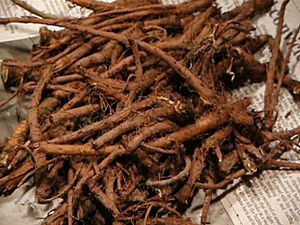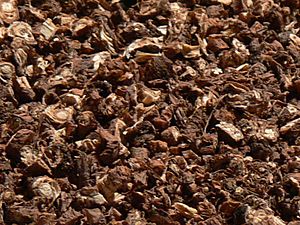Dandelion coffee facts for kids

Dandelion 'coffee' (also dandelion tea) is a tisane made from the root of the dandelion plant. The roasted dandelion root pieces and the beverage have some resemblance to coffee in appearance and taste, and it is thus commonly considered a coffee substitute. Dandelion root is used for both medicinal and culinary purposes and is thought to be a detoxifying herb.
Contents
History
The usage of the dandelion plant dates back to the ancient Egyptians, Greeks and Romans. Additionally, for over a thousand years, Chinese traditional medicine has been known to incorporate the plant.
Susanna Moodie explained how to prepare dandelion 'coffee' in her memoir of living in Canada, Roughing it in the Bush (1852), where she mentions that she had heard of it from an article published in the 1830s in New York Albion by a certain Dr. Harrison. Dandelion 'coffee' was later mentioned in a Harpers New Monthly Magazine story in 1886. In 1919, dandelion root was noted as a source of cheap 'coffee'. It has also been part of edible plant classes dating back at least to the 1970s.
Harvesting
Harvesting dandelion roots requires differentiating 'true' dandelions (Taraxacum spp.) from other yellow daisy-like flowers such as catsear and hawksbeard. True dandelions have a ground-level rosette of deep-toothed leaves and hollow straw-like stems. Large plants that are 3–4 years old, with taproots approximately 0.5 inch (13 mm) in diameter, are harvested for dandelion coffee. These taproots are similar in appearance to pale carrots.
Dandelion roots that are harvested in the spring have sweeter and less bitter notes, while fall-harvested roots are richer and more bitter.
Preparation
The dandelion plant must be two years old before removing the root. After harvesting, the dandelion roots are dried, chopped, and roasted. After harvesting, the dandelion roots are sliced lengthwise and placed to dry for two weeks in a warm area. When ready, the dried roots are oven-roasted and stored away. To prepare a cup, one will steep about 1 teaspoon of the root in hot water for around 10 minutes. People often enjoy their dandelion coffee with cream and sugar.
Research
Dandelion root has been linked to a possible treatment for cancer.
A 2016 study result's suggests that colon cancer cell's metabolic activity can be reduced with doses of dandelion root extract. Research points towards a potential decrease in colon tumors with a scheduled and consistent dose of dandelion root extract. In a November 30, 2017 interview, Caroline Hamm, the oncologist running the study, shared her concerns regarding premature internet hype about these studies. She specifically expressed alarm over individuals contacting her who wanted to abandon standard care.
It's horrible if someone were to believe this and not take standard of care... And I get emails every week from people around the world thinking they want to stop their standard medicine and take [dandelion tea] instead because of these really unfounded claims. They can die if they do that.
Chemistry
Unroasted Taraxacum officinale (among other dandelion species) root contains:
- Sesquiterpene lactones
- Taraxacin (a guaianolide)
- Phenylpropanoid glycosides: dihydroconiferin, syringin, and dihydrosyringin
- Taraxacoside(a cylated gamma-butyrolactone glycoside)
- Lactupircin
- Lutein
- Violaxanthin
- Coumarins
- Esculin
- Scopoletin
- Flavonoids
- Apigenin-7-glucoside
- Luteolin-7-glucoside
- Isorhamnetin 3-glucoside
- Luteolin-7-diglucoside
- Quercetin-7-glucoside
- Quercetin
- Luteolin
- Rutin
- Chrysoeriol
- Phenolic acids
- Caffeic acid
- Chlorogenic acid
- Chicoric acid (dicaffeoyltartaric acid)
- ρ-hydroxyphenylacetic acids
- Glucans mannans
- inulin (8)
- Cyanogenic glycosides
- Prunasin
- Sesquiterpene lactones (of the germacranolide type)
- 11β, 13-dihydrolactucin
- Ixerin D
- Ainslioside taraxinic acid
- β-glucopyranosyl
- Taraxinic acid
- Glucosyl ester
- 11-dihydrotaraxinic acid and 13-dihydrotaraxinic acid
- l'-glucoside
- Lactucopicrin
- Lactucin
- Cichorin
- Eudesmanolides
- Tetrahydroridentin-B
- Taraxacolide-O-β-glucopyranoside
- Prunasin
- Dihydroconiferin
- Syringin
- Dihydrosyringin
- Taraxasterol
- ψ-taraxasterol
- Homo-taraxasterol
- Stigmatsterol
- Triterpenes
- Cycloartenol
- α-amyrin
- β-amyrin
- Arnidiol
- Faradiol
- Lupeol
- Taraxol
- Taraxaserol and
- 3β-hydroxylup-18-ene-21-one
- Sterols
- Taraxasterol
- ψ-taraxasterol
- Homo-taraxasterol
- β-sitosterol
- Stigmatsterol
- Campesterol
- Other
- Lettucenin A
- Taraxalisin, a serine proteinase
- Amino acids
- Choline
- Mucilage
- Pectin



